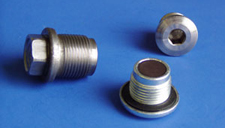REQUEST A QUOTE
CONTACT US
ISO 9001:2015 Certified
Case Studies
Rubber Magnet
Rubber Magnet Allows Magnetic Drain Plug Redesign

Plastalloy, a high-energy material that maintains its superior performance characteristics when subjected to the rigors of service in a hot oil environment, can also withstand the high impact of a crimping press, and can survive being dropped from virtually any height. That’s what prompted design engineers from General Plug and Manufacturing to redesign their magnetic drain plugs to incorporate the benefits of the virtually unbreakable Plastalloy material. Their patent-pending result is more aesthetically appealing, offers increased customer benefits, and it is simpler to produce.
Drain plugs are pretty straightforward. A threaded plug fitted with some kind of secondary seal assembles into a tapped hole in an engine oil drain pan or a differential housing. Many manufacturers simply affix a magnet to a standard designed plug to catch ferrous particles in the oil stream.
Another mounting method utilizes a set-screw through a hole in the middle of the magnet. This requires extra labor to tighten the screw, and is problematic if too much force is applied (again cracking the brittle magnetic materials). Epoxies also suffice for holding magnets in place, but this method is troublesome as the epoxy is messy, requires considerable labor to install, and time to cure, thus complicating the manufacturing procedure.
To eliminate these problems, General Plug forms a pocket in the end of the drain plug, and then inserts the rubber bonded Plastalloy high-energy magnet into the pocket. Material from the rim of the pocket is then roll-formed over the Plastalloy during the patented process, holding it firmly in place. The “bead” that is rolled over the magnets edge is both uniform and functional, ensuring that the magnet is held firmly in place with no sharp edges to harm those removing or installing the drain plug.
Unlike the sintered materials, Plastalloy is resilient and durable enough to withstand the roll forming procedure. Since it requires no additional materials, retention by roll forming results in a more attractive and cost-effective end product than one where retention is achieved by means of epoxies, adhesives or retaining screws.
Plugs with straight threads are easier to install and remove as they require no thread sealing. A seal is typically assembled between the underside of the plug head and the mating surface of the drain hole. Fiber, plastic, copper or other materials have been used as seals. While temporarily effective, they loosen during use, requiring retightening or alternately, producing leaks if not tightened, which implies poor quality.
The patent-pending General Plug design features metal-to-metal contact between the bearing surface of the plug and the bearing surface of the tapped hole. This allows a proper torque-tension relationship to be maintained on the assembled plug. Sealing is accomplished by encasing an elastomeric washer-seal within a groove formed on the underside of the head of the plug (see drawing). Since straight threads are used, the plugs can readily be installed and removed.
Initially, the design is available in M20 and M22 sizes, though VP of Sales Jerry Jenkins is quick to point out that other sizes are attainable.
Magnetic drain plugs are useful in many industrial and commercial applications, including automotive & transportation industries, power transmission products, or any system that benefits from the removal of suspended ferrous particles. With high-energy Plastalloy rubber bonded magnets on the “business end” of the drain plug, design engineers and mechanics alike can rest assured that the plug will provide many years of trouble free service.

